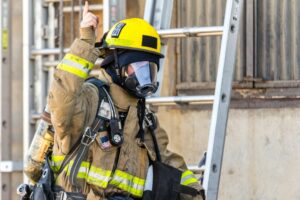How First Responders’ Safety Shapes Effective Hazardous Releases and Exposure Responses


When hazardous materials are released unexpectedly or dangerous exposures threaten communities, first responders step in immediately. Their role goes beyond just arriving on the scene — first responders’ safety is the backbone that supports every action they take. Prioritizing safety ensures they protect themselves, the public, and the environment while managing emergencies effectively. Understanding how first responders’ safety drives their work helps reveal why this focus is crucial in hazardous releases and exposures.
The Crucial Role of First Responders’ Safety in Hazardous Emergencies
First responders’ safety is the top priority during any hazardous release or exposure event. Firefighters, police officers, EMTs, and specialized HazMat teams operate in highly volatile situations. Without a firm commitment to their safety, responders risk injury, contamination, or even death, which would severely hamper emergency efforts.
Therefore, every action—from assessing the scene to deploying containment measures—starts with a safety mindset. For instance, before entering an area with a chemical spill, responders evaluate risks and don appropriate personal protective equipment (PPE). This careful planning minimizes harm and maximizes the chance of a successful response.
Training: The Foundation of First Responders’ Safety
Training forms the core of first responders’ safety. Agencies invest heavily in preparing teams for hazardous material incidents. Training programs teach responders to identify chemicals, understand exposure routes, and use PPE correctly. In addition, responders practice decontamination procedures, emergency evacuation methods, and how to work with specialized detection equipment.
Regular drills simulate real-world scenarios, helping responders maintain skills and build teamwork. These exercises encourage quick decision-making while reinforcing safety protocols. Moreover, they improve communication during chaos, which directly impacts the safety of the team and the public.
Essential Equipment for Ensuring First Responders’ Safety
Equipment serves as a first line of defense in protecting responders. Personal protective equipment, including respirators, chemical-resistant suits, gloves, and eye protection, forms the basic barrier against hazardous agents. Choosing the correct PPE depends on the type and level of hazard encountered.
Beyond PPE, detection devices play a vital role in first responders’ safety. Portable gas detectors, radiation monitors, and chemical identification tools allow responders to assess hazards from a safe distance before direct exposure. Specialized vehicles equipped with containment and decontamination tools further reduce direct contact with dangerous materials.
Maintaining and inspecting this equipment regularly ensures it functions properly when seconds matter.
Communication: A Pillar of Safety and Response Coordination
Effective communication significantly enhances first responders’ safety. Dispatch centers provide responders with vital information about the nature of the hazardous release and potential dangers. Real-time updates enable teams to adjust tactics promptly.
At the incident site, responders communicate hazards, changing conditions, and resource needs. Coordinated communication also extends to external agencies such as environmental protection and medical teams. This collaboration creates a unified approach, preventing missteps that could jeopardize safety.
Without strong communication, responders risk working unthinkingly in hazardous environments, increasing the chance of accidents.
Balancing Public Protection with First Responders’ Safety
While protecting the public remains the primary goal, first responders cannot compromise their safety. Establishing secure perimeters prevents civilians from entering dangerous areas. Evacuations are carefully planned and executed to minimize exposure while keeping responders safe.
Public education about hazards and emergency procedures plays a critical role in easing the burden on responders. When communities understand how to react and follow instructions, responders face fewer complications. This balance between public safety and responder safety ensures the emergency is contained without worsening the situation.
Cleanup and Recovery: Extending First Responders’ Safety Beyond the Incident
First responders’ safety continues after the initial emergency phase. During cleanup, responders work with environmental teams to remove contaminants and restore safety. Following strict protocols for handling hazardous waste prevents secondary exposure.
Decontamination processes also protect responders and equipment. Continuous monitoring of the site after cleanup ensures hazards do not resurface, protecting both people and wildlife.
The cleanup phase demands ongoing attention to safety, as new risks may emerge.
Addressing Mental and Physical Health to Support First Responders’ Safety
Responding to hazardous releases often puts a heavy mental and physical strain on first responders. The stress of working in dangerous conditions, sometimes witnessing injuries or fatalities, impacts their well-being. Agencies recognize this and provide counseling, peer support programs, and fitness initiatives.
Maintaining mental and physical health directly supports first responders’ safety. Alert, fit responders make better decisions and reduce the risk of accidents caused by fatigue or stress. Investing in wellness programs strengthens teams and improves overall emergency response.
The Future of First Responders’ Safety in Hazardous Releases
Emerging technologies promise to enhance first responders’ safety further. Advances in sensor technology allow earlier detection of hazardous materials, giving responders more time to prepare. Drones equipped with cameras and chemical sensors can survey dangerous areas without risking personnel.
Virtual reality training now offers responders realistic, immersive drills to refine their safety skills. Additionally, new protective materials improve the comfort and effectiveness of PPE, encouraging longer use when needed.
Communities increasingly support investments in safety infrastructure and public awareness campaigns, helping reduce hazardous incidents. First responders’ safety remains a dynamic field, adapting continuously to new challenges.
First responders’ safety plays an essential role in every step of managing hazardous releases and exposures. Their dedication to protecting themselves, the public, and the environment enables effective and rapid emergency response. Through rigorous training, proper equipment, strong communication, and ongoing health support, first responders maintain safety even in the most dangerous situations. As technology advances and safety protocols evolve, these heroes will continue safeguarding communities with skill and courage.
